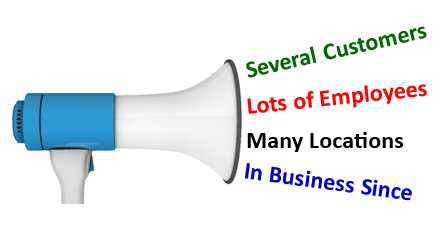There is an increase in the number of companies touting company numbers especially from large multinational firms. This is an encouraging development, in that organizations are relying a little less on clichéd content and are making efforts to distinguish their businesses with real numbers.
However, the use of company statistics to convey value is often misused by companies.
The kind of metrics often displayed as if they are competitive advantages are:
- Served 3 million customers
- Have 62 locations across the globe
- Employ over 10,000 people
- In business for 50 years
These simply convey “we’re big” or “we’ve been around.” In fact, when longevity is tested in double blind customer surveys it is most often rated low as a buying criterion. Yet companies love to brag about it. Younger generations do not relate to decades of experience, and they are often making buying decisions today.
As an example, distributors and service providers often wonder how important it is in the buying decision that they have a facility or offices near their customers. We’ve tested some form of ‘proximity,’ ‘locations,’ ‘close by’ for several organizations within the past few years, and here’s what we’ve learned:
When buyers evaluate/choose a seller, location rated in the bottom quartile in importance as part of their decision hierarchy. Things like responsiveness and accuracy score higher, yet many organizations fail to address these attributes in favor of touting locations. That’s why this type of data point is referred to as vanity metrics, which are not to be confused with competitive advantages.
For B2B manufacturers, a couple of attributes often show up in the lowest quartile in buyer importance in studies we have conducted:
- Innovation
- Speed of providing a quote
While somewhat surprising, customers rated many other deliverables much higher in deciding who best delivers what they value most.
Manufacturers like to communicate how innovative they are, but the reality is that buyers mostly value products delivered reliably more than working with someone who touts a lot of innovation bells and whistles.
And when it comes to providing good customer service, providing a quote quickly isn’t how buyers define it. Also, often a surprise.
Caveat: these quoted studies do not apply to manufacturers and distributors universally. They are just shown as examples of how often vanity metrics do not add value or win customers.
Competitive Advantage isn’t necessarily what you are good at or proud of, but rather what ranks high in the customers’ grading of buying criteria.
If the goal is to communicate a competitive advantage, the proliferation of data within content often misses the goal. A differentiator is only a competitive advantage if it is valued by your customers and prospects. Otherwise, a company’s portrayal of data is little more than an expression of their pride. Vanity metrics. And they often drown out the most important messages that should be front and center.
February, 2024



